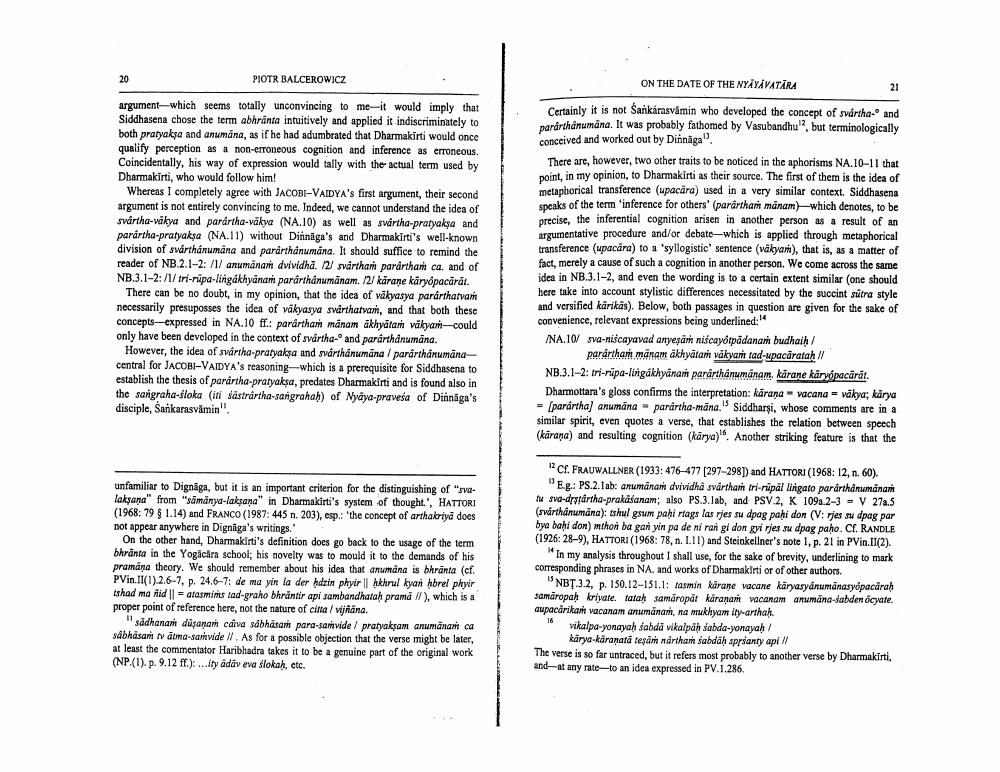Book Title: On The Date Of The Nnyayavatara Author(s): Piotr Balcerowicz Publisher: Piotr Balcerowicz View full book textPage 3
________________ PIOTR BALCEROWICZ argument which seems totally unconvincing to me-it would imply that Siddhasena chose the term abhränta intuitively and applied it indiscriminately to both pratyaksa and anumana, as if he had adumbrated that Dharmakirti would once qualify perception as a non-erroneous cognition and inference as erroneous. Coincidentally, his way of expression would tally with the actual term used by Dharmakirti, who would follow him! 20 Whereas I completely agree with JACOBI-VAIDYA's first argument, their second argument is not entirely convincing to me. Indeed, we cannot understand the idea of svartha-väkya and parårtha-vakya (NA.10) as well as svartha-pratyaksa and parartha-pratyaksa (NA.11) without Dinnaga's and Dharmakirti's well-known division of svårthanumana and parârthánumäna. It should suffice to remind the reader of NB.2.1-2: /1/ anumanam dvividhä. 121 svårtham parårtham ca. and of NB.3.1-2: /1/ tri-rupa-lingakhyānam parârthânumānam. 121 kärane käryôpacārāt. There can be no doubt, in my opinion, that the idea of vakyasya parárthatvam necessarily presuposses the idea of vakyasya svårthatvam, and that both these concepts-expressed in NA.10 ff.: parârtham manam äkhyātam vākyam-could only have been developed in the context of svårtha- and pararthânumana. However, the idea of svartha-pratyaksa and svarthânumana / parârthânumāna central for JACOBI-VAIDYA's reasoning-which is a prerequisite for Siddhasena to establish the thesis of parârtha-pratyaksa, predates Dharmakirti and is found also in the sangraha-sloka (iti sastrartha-sangrahaḥ) of Nyaya-pravesa of Dinnaga's disciple, Sankarasvamin". unfamiliar to Dignaga, but it is an important criterion for the distinguishing of "svalakṣaṇa" from "sāmānya-lakṣaṇa" in Dharmakirti's system of thought.", HATTORI (1968: 79 § 1.14) and FRANCO (1987: 445 n. 203), esp.: 'the concept of arthakriya does not appear anywhere in Dignaga's writings." On the other hand, Dharmakirti's definition does go back to the usage of the term bhränta in the Yogäcära school; his novelty was to mould it to the demands of his pramana theory. We should remember about his idea that anumana is bhränta (cf. PVin.II(1).2.6-7, p. 24.6-7: de ma yin la der hdzin phyir || ḥkhrul kyan hbrel phyir tshad ma ñid = atasmims tad-graho bhräntir api sambandhataḥ prama //), which is a proper point of reference here, not the nature of citta / vijñāna. "sadhanam düşaṇam caiva sábhásam para-samvide / pratyakşam anumanam ca sabhasam tv atma-samvide II. As for a possible objection that the verse might be later, at least the commentator Haribhadra takes it to be a genuine part of the original work (NP.(1). p. 9.12 ff.):...ity adav eva slokaḥ, etc. ON THE DATE OF THE NYAYAVATARA 21 Certainly it is not Šankárasvamin who developed the concept of svartha- and parárthanumana. It was probably fathomed by Vasubandhu', but terminologically conceived and worked out by Dinnaga". There are, however, two other traits to be noticed in the aphorisms NA.10-11 that point, in my opinion, to Dharmakirti as their source. The first of them is the idea of metaphorical transference (upacara) used in a very similar context. Siddhasena speaks of the term 'inference for others' (parartham manam) which denotes, to be precise, the inferential cognition arisen in another person as a result of an argumentative procedure and/or debate-which is applied through metaphorical transference (upacära) to a 'syllogistic' sentence (väkyam), that is, as a matter of fact, merely a cause of such a cognition in another person. We come across the same idea in NB.3.1-2, and even the wording is to a certain extent similar (one should here take into account stylistic differences necessitated by the succint sutra style and versified kärikäs). Below, both passages in question are given for the sake of convenience, relevant expressions being underlined: 14 /NA.10/ sva-niscayavad anyeşām niscayôtpadanam budhaiḥ/ parartham manam akhyātam vakyaṁ tad-upacarataḥ || NB.3.1-2: tri-rupa-lingakhyānam pararthânumanam, kärane käryōpacärät. Dharmottara's gloss confirms the interpretation: käraṇa vacana = vākya; kārya = [parártha] anumana parártha-mana." Siddharși, whose comments are in a similar spirit, even quotes a verse, that establishes the relation between speech (karana) and resulting cognition (karya). Another striking feature is that the 12 Cf. FRAUWALLNER (1933: 476-477 [297-298]) and HATTORI (1968: 12, n. 60). E.g.: PS.2.1ab: anumanam dvividha svartham tri-rupal lingato parârthânumānam tu sva-drstårtha-prakāśanam; also PS.3.1ab, and PSV.2, K 109a.2-3 V 27a.5 (svårthânumana): tshul gsum pahi rtags las rjes su dpag pahi don (V: rjes su dpag par bya bahi don) mthon ba gan yin pa de ni ran gi don gyi rjes su dpag paho. Cf. RANDLE (1926: 28-9), HATTORI (1968: 78, n. 1.11) and Steinkellner's note 1, p. 21 in PVin.II(2). "In my analysis throughout I shall use, for the sake of brevity, underlining to mark corresponding phrases in NA. and works of Dharmakirti or of other authors. 15 NBT.3.2, p. 150.12-151.1: tasmin kärane vacane karyasyânumānasyopacāraḥ samaropaḥ kriyate. tataḥ samäropät käraṇam vacanam anumana-sabden ócyate. aupacärikaṁ vacanam anumanam, na mukhyam ity-arthah 16 vikalpa-yonayaḥ śabda vikalpäḥ śabda-yonayaḥ/ karya-käraṇatā teṣāṁ nártham sabdäḥ sprianty api// The verse is so far untraced, but it refers most probably to another verse by Dharmakirti, and at any rate-to an idea expressed in PV.1.286.Page Navigation
1 2 3 4 5 6 7 8 9 10 11 12 13 14 15 16 17 18 19 20 21
